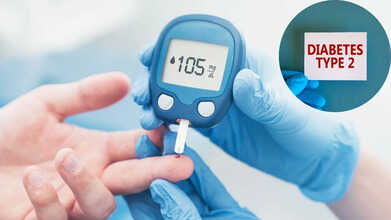- Health Conditions A-Z
- Health & Wellness
- Nutrition
- Fitness
- Health News
- Ayurveda
- Videos
- Medicine A-Z
- Parenting
- Web Stories
Why Do I Get Bad Dreams When I Am Sick?

Credits: Canva
What's worse than running nose, continuous sneezing, and a fever? It is the dreams you get when you have finally managed to put yourself to sleep, and those dreams are bad, scary, intense, and negative. Why does this happen?
What Is A Fever Dream?
A dream is basically a series of thoughts, images, sensations that you feel while you are sleeping, and scientists tell us that we have our strongest dreams during the rapid eye movement or the REM of the sleep stage.
Certain factors, including you health could influence your sleep visions and your dreams. A change in body temperature, especially when it is higher than usual could lead to a fever dream, which mostly could be intense, like a nightmare.
As per a 2016 study published in the International Journal of Dream Research, 94 per cent of participants described their fever dreams as negative. Another 2013 study noted that one of the participants had dreams that would move "back and forth between a very difficult circumstance and a very comfortable circumstance." A recent online study in 2020, published in the journal Frontiers Psychology noted that of the 164 participants, 100 of them reported fever dreams. Most of them said that fever dreams were more bizarre, and negatively toned.
While fever dream is known in the medical literature, the scientific studies on the same are limited. Many often describe this as an emotionally intense, troubling, strange, out of character, or a scary dream. The dreams could be the result of less social interactions due to someone being sick.
When Does A Fever Dream Happen?
A fever dream happens when the normal body temperature rises 2 degrees above. The normal body temperature is between 97 and 99 degree F. Anyone can develop a fever, due to the following conditions:
- a viral or bacterial infection
- heat exhaustion
- certain inflammatory conditions such as rheumatoid arthritis
- medicines, such as antibiotics
- an immunization
- a tumor
Why Do You Get Bad Dreams During Fever?
While there is no exact reasoning for it, the 2020 online study notes that the concept behind this is the 'over-heated' brain. High temperature of the body could disrupt the brain's normal cognitive functions. The authors of the 2020 study note, "The basic idea is that the ‘over-heated’ brain is not functioning properly and, therefore, dreams are more bizarre.”
During the REM stage of sleep, the phase where your most vivid dreams unfold, the body already struggles to regulate its internal temperature. When a fever strikes, it disrupts this delicate balance even further, often resulting in intense or disturbing dreams. Fevers can also stir the mind in other unsettling ways, sometimes causing waking hallucinations, irritability, or even brief episodes of confusion.
Dr Mark Rosenblum, who is a sleep psychologist with Hennepin Healthcare, tells CBS News that the reason behind intense dream during sickness is due to REM. He says, "If someone's not getting enough sleep, they get what's called REM rebound on the following nights. And when we have REM rebound, what we'll find is all our dreams tend to be very intense."
Are There Any Symptoms Of Fever Dreams?
As per a 2016 study published in the International Journal of Dream, fever dreams contain some sort of spatial distortion, that include:
- Moving walls
- Creatures with oversized arms and legs
- Metal spheres that move like an organism
- Blackness spreading slowly
- Gigantic insects
THIS Is The Age Sperm Quality Starts Declining: Study Reveals Age When Risk Of Passing Down Mutations Increases

(Credit-Canva)
Many people are choosing to become parents later in their lives. Whether it is due to financial reasons or due to difficulty conceiving, etc. However, many people bring up the ‘biological clock’ argument. While it is possible to have pregnancy later in life, there are some health implications, not just for the mother, but also for the child. Many people often place this responsibility on women. However, a new study shows that fathers who have children later in life may also risk passing down harmful mutations.
New research shows that as men get older, their sperm collects harmful mutations, which can raise the risk of health issues in their children.
Researchers in the UK studied sperm samples from 81 healthy men, ranging in age from 24 to 75. Using a highly accurate testing method, the team found that harmful changes, or mutations, build up in sperm over time. Simply put, the older a man is, the more his sperm’s genetic quality declines.
How Does Old Sperm Affect Offspring's Health?
The study identified over 40 genes that cause the sperm stem cells to mutate. This genetic process is known as "selfish sperm."
What's most alarming is that these harmful mutations don't just accumulate; they are actually favored during the creation of new sperm. This means that sperm cells carrying the mutations multiply and out-compete the healthy sperm, leading to a higher proportion of damaged cells. This process can lead to a two to three times higher risk of passing on disease-causing mutations. The study measured the percentage of sperm carrying disease-causing mutations and found a clear increase with age:
- Early 30s (26–42 years): About 2% of sperm carried disease-causing mutations.
- Middle-Aged and Older (43–74 years): This percentage rises significantly to between 3% and 5%.
- The overall rate of accumulation was calculated to be about 1.67 new mutations every year.
- The research specifically suggests that the genetic quality of a man's sperm starts to decline noticeably around age 43.
How Does Late Parenthood Affect Children?
These mutated genes are linked to developmental disorders and inherited syndromes that can increase the risk of certain cancers. The mutations that increase most sharply as the father ages are connected to severe neurodevelopmental disorders in children, including some conditions on the autism spectrum.
The study confirmed that specific rare genetic disorders, such as Apert, Noonan, and Costello syndromes, are rooted in this “selfish sperm” phenomenon.
These findings are particularly important today because older fatherhood is becoming much more common. The number of fathers over the age of 40 nearly doubled between 1972 and 2015.
This trend concerns the given related data: a recent analysis found that fathers over 40 had a 51% greater chance of having a child diagnosed with autism compared to fathers under 30.
While these results highlight an increased risk that older fathers should be aware of, the researchers stress that more study is needed. They also point out that while the number of mutated sperm increases with age, not all of them will lead to a successful pregnancy, as some may prevent fertilization or cause miscarriage.
This FDA-Approved Drug Combo Could Reduce Risk Of Prostate Cancer Deaths By 40%

(Credit-Canva)
Prostate cancer is one of the most common cancers in men. About 1 in 8 men are at risk of prostate cancer diagnosis and about 1 in 44 men die due to it, according to the American Cancer Society. While the rates of deaths related to prostate cancer have declined in recent years, this decline rate has slowed down, meaning that more cancers are being detected at an advanced stage.
However, a new clinical trial could help turn these statistics around. This is not a new medicine, this treatment regime is based on two FDA-approved drugs, and it is showing some promising results.
A new clinical trial shows that a combination of two drugs can dramatically help men whose prostate cancer has returned following surgery or radiation. This new therapy was found to cut the risk of death by more than 40% in this high-risk group.
The successful regimen combines the drug enzalutamide with the standard hormone therapy doctors typically prescribe. This dual approach resulted in a major reduction in deaths for patients with recurrent prostate cancer who previously had very few effective treatment options left.
The highly anticipated results were published in The New England Journal of Medicine (NEJM) and presented simultaneously at the European Society for Medical Oncology Congress (ESMO) on October 19.
Why Is Prostate Cancer Considered High Risk?
The American Cancer Society estimates for 2025 are about 313,780 new cases of prostate cancer diagnosis and 35,770 deaths from it. One of the best ways to combat cancer is early diagnosis, however, missing symptoms is very easy. With the help of this medicinal regime, many people can avoid facing harsh cancer treatments.
The clinical trial was extensive, involving over 1,000 patients from hundreds of medical facilities across 17 different countries. All of the men were diagnosed with a condition known as high-risk biochemically recurrent prostate cancer.
This specific diagnosis is given to men whose blood levels of a protein called PSA (Prostate Specific Antigen) suddenly start to climb rapidly after they've had surgery or radiation. Doctors use the PSA protein to track the cancer, and a quick rise is a strong signal that the cancer is highly likely to come back and spread to other areas, most often the bones or spine. Without a truly powerful treatment, these patients face a high risk of developing widespread cancer and possibly dying from their disease.
What Medicine Can Reduce the Risk Of Prostate Cancer?
In the study, the men were randomly put into three groups: one group got only the standard hormone therapy, one got only enzalutamide, and the third got the combination of both drugs. After the men were tracked for eight years, the group that received the combination treatment had a death rate that was 40.3% lower than the other two groups.
These excellent results are expected to quickly change the way doctors treat this type of cancer everywhere. The drug enzalutamide is already approved by government agencies and listed in major cancer treatment guidelines based on previous studies.
These latest results will likely make the recommendation even stronger, confirming that this drug combination should become the standard treatment for men with this aggressive, recurrent prostate cancer. This outcome supports earlier research and will significantly improve how doctors care for their patients.
Symptoms of Prostate Cancer You Should Know.
While researchers are working on ways to improve prostate cancer treatment, one must know how to spot any symptoms of it as well. According to the National Health Service UK, prostate cancer has no symptoms at first. However, as the cancer starts growing on the outer parts of the prostate, you may notice some problems.
- Having a hard time getting your urine flow to start, or needing to push or strain to get the urine out.
- When you do urinate, the flow is much weaker than usual.
- Your stream stops and starts multiple times while you're trying to empty your bladder.
- Suddenly seeing a rise in the urgency and frequency of needing to urinate, than what you usually feel.
- Feeling like your bladder isn't completely empty, even right after you finish urinating.
- Waking up many times during the night because you need to urinate.
Some symptoms of advanced prostate cancer include
- Erectile dysfunction
- Blood in your urine or semen
- Lower back pain and unexpected weight loss.
Blood Sugar Levels In Type 2 Diabetes: What Counts As High, Low, Or Normal?

Credits: Canva
Type 2 diabetes is a long-term condition where your body either doesn’t produce enough insulin or can’t use the insulin it makes properly, causing blood sugar levels to rise. Keeping an eye on your blood sugar is essential for managing the condition and protecting your overall health.
A blood sugar chart can help you understand what’s normal, too high, or too low. By getting familiar with these ranges, you can work with your doctor to maintain healthy levels and reduce the risk of complications. Below, we break down everything you need to know about type 2 diabetes.
What is Type 2 diabetes?
Type 2 diabetes (T2D) occurs when blood sugar (glucose) remains consistently high. Normal blood sugar levels fall between 70 and 99 milligrams per deciliter (mg/dL). If undiagnosed, Type 2 diabetes often shows levels of 126 mg/dL or more.
T2D happens because the pancreas doesn’t produce enough insulin, the body can’t use insulin effectively, or a combination of both. This differs from Type 1 diabetes, which arises when the immune system attacks the pancreas, leaving the body unable to produce insulin at all.
How Common Is Type 2 Diabetes?
Type 2 diabetes is widespread. Over 37 million people in the U.S. have diabetes (around 1 in 10), with 90–95% of cases being T2D. Globally, it affects roughly 6.3% of the population. While it’s most common in adults over 45, younger adults and even children can develop it.
Blood Sugar Range For Adults With Type 2 Diabetes And Children With Type 2 Diabetes
The American Diabetes Association recommends the following ranges for adults with type 1 or type 2 diabetes and children with type 2 diabetes:
| Time | Recommended Blood Sugar Range |
| Fasting (before eating) | 80 to 130 mg/dL |
| 1 to 2 hours after meal | Lower than 180 mg/dL |
Is Type 2 Diabetes Genetic?
T2D has complex causes, but genes play a significant role. If one biological parent has T2D, your lifetime risk is around 40%, and if both parents do, it rises to 70%. Scientists have identified over 150 DNA variations linked to T2D risk, some increase the chance of insulin resistance or reduced insulin production, while others influence obesity risk. These genetic factors interact with lifestyle and health habits to determine overall risk.
How is Type 2 Diabetes Diagnosed?
Doctors use several blood tests to confirm T2D:
- Fasting plasma glucose test: Measures blood sugar after an eight-hour fast. A result of 126 mg/dL or higher indicates diabetes.
- Random plasma glucose test: Measures blood sugar at any time without fasting. A reading of 200 mg/dL or higher signals diabetes.
- A1C test: Reflects average blood sugar over the past 2–3 months. A level of 6.5% or higher indicates diabetes.
What Is A1C?
A1C shows your average blood sugar for the past three months. When sugar circulates in your blood, it attaches to a protein called hemoglobin. Higher blood sugar levels result in a higher percentage of hemoglobin coated with sugar. Your A1C result helps indicate whether your blood sugar is normal, prediabetic, or diabetic.
The chart below shows where your A1C result stands, whether it is within a healthy range or could indicate prediabetes or diabetes.
| Diagnosis | AIC Result |
| Normal | less than 5.7% |
| Prediabetes | between 5.7% and 6.4% |
| Diabetes | 6.5% and higher |
© 2024 Bennett, Coleman & Company Limited

